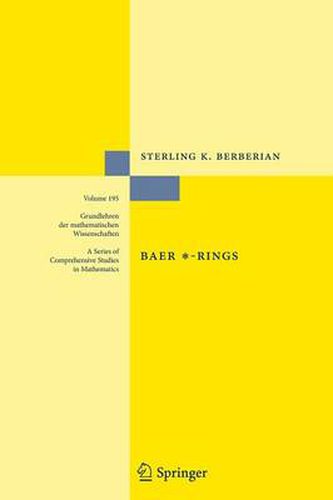Readings Newsletter
Become a Readings Member to make your shopping experience even easier.
Sign in or sign up for free!
You’re not far away from qualifying for FREE standard shipping within Australia
You’ve qualified for FREE standard shipping within Australia
The cart is loading…






This title is printed to order. This book may have been self-published. If so, we cannot guarantee the quality of the content. In the main most books will have gone through the editing process however some may not. We therefore suggest that you be aware of this before ordering this book. If in doubt check either the author or publisher’s details as we are unable to accept any returns unless they are faulty. Please contact us if you have any questions.
This book is an elaboration of ideas of Irving Kaplansky introduced in his book Rings of operators ([52], [54]). The subject of Baer *-rings has its roots in von Neumann’s theory of ‘rings of operators’ (now called von Neumann algebras), that is, *-algebras of operators on a Hilbert space, containing the identity op- ator, that are closed in the weak operator topology (hence also the name W*-algebra). Von Neumann algebras are blessed with an excess of structure-algebraic, geometric, topological-so much, that one can easily obscure, through proof by overkill, what makes a particular theorem work. The urge to axiomatize at least portions of the theory of von N- mann algebras surfaced early, notably in work of S. W. P. Steen [84], I. M. Gel'fand and M. A. Naimark [30], C. E. Rickart 1741, and von Neumann himself [53]. A culmination was reached in Kaplansky’s AW*-algebras [47], proposed as a largely algebraic setting for the - trinsic (nonspatial) theory of von Neumann algebras (i. e., the parts of the theory that do not refer to the action of the elements of the algebra on the vectors of a Hilbert space). Other, more algebraic developments had occurred in lattice theory and ring theory. Von Neumann’s study of the projection lattices of certain operator algebras led him to introduce continuous geometries (a kind of lattice) and regular rings (which he used to ‘coordinatize’ certain continuous geometries, in a manner analogous to the introd- tion of division ring coordinates in projective geometry).
$9.00 standard shipping within Australia
FREE standard shipping within Australia for orders over $100.00
Express & International shipping calculated at checkout
This title is printed to order. This book may have been self-published. If so, we cannot guarantee the quality of the content. In the main most books will have gone through the editing process however some may not. We therefore suggest that you be aware of this before ordering this book. If in doubt check either the author or publisher’s details as we are unable to accept any returns unless they are faulty. Please contact us if you have any questions.
This book is an elaboration of ideas of Irving Kaplansky introduced in his book Rings of operators ([52], [54]). The subject of Baer *-rings has its roots in von Neumann’s theory of ‘rings of operators’ (now called von Neumann algebras), that is, *-algebras of operators on a Hilbert space, containing the identity op- ator, that are closed in the weak operator topology (hence also the name W*-algebra). Von Neumann algebras are blessed with an excess of structure-algebraic, geometric, topological-so much, that one can easily obscure, through proof by overkill, what makes a particular theorem work. The urge to axiomatize at least portions of the theory of von N- mann algebras surfaced early, notably in work of S. W. P. Steen [84], I. M. Gel'fand and M. A. Naimark [30], C. E. Rickart 1741, and von Neumann himself [53]. A culmination was reached in Kaplansky’s AW*-algebras [47], proposed as a largely algebraic setting for the - trinsic (nonspatial) theory of von Neumann algebras (i. e., the parts of the theory that do not refer to the action of the elements of the algebra on the vectors of a Hilbert space). Other, more algebraic developments had occurred in lattice theory and ring theory. Von Neumann’s study of the projection lattices of certain operator algebras led him to introduce continuous geometries (a kind of lattice) and regular rings (which he used to ‘coordinatize’ certain continuous geometries, in a manner analogous to the introd- tion of division ring coordinates in projective geometry).